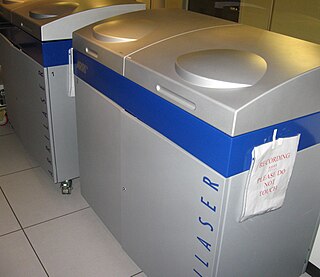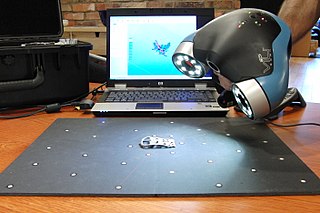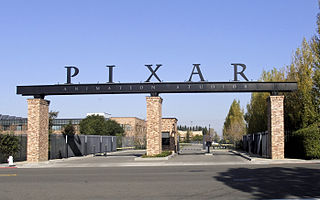
Telecine is the process of transferring motion picture film into video and is performed in a color suite. The term is also used to refer to the equipment used in the post-production process. Telecine enables a motion picture, captured originally on film stock, to be viewed with standard video equipment, such as television sets, video cassette recorders (VCR), DVD, Blu-ray Disc or computers. Initially, this allowed television broadcasters to produce programmes using film, usually 16mm stock, but transmit them in the same format, and quality, as other forms of television production. Furthermore, telecine allows film producers, television producers and film distributors working in the film industry to release their products on video and allows producers to use video production equipment to complete their filmmaking projects. Within the film industry, it is also referred to as a TK, because TC is already used to designate timecode.
Digital Picture Exchange (DPX) is a common file format for digital intermediate and visual effects work and is a SMPTE standard. The file format is most commonly used to represent the density of each colour channel of a scanned negative film in an uncompressed "logarithmic" image where the gamma of the original camera negative is preserved as taken by a film scanner. For this reason, DPX is the worldwide-chosen format for still frames storage in most digital intermediate post-production facilities and film labs. Other common video formats are supported as well, from video to purely digital ones, making DPX a file format suitable for almost any raster digital imaging applications. DPX provides, in fact, a great deal of flexibility in storing colour information, colour spaces and colour planes for exchange between production facilities. Multiple forms of packing and alignment are possible. The DPX specification allows for a wide variety of metadata to further clarify information stored within each file.
Digital intermediate is a motion picture finishing process which classically involves digitizing a motion picture and manipulating the color and other image characteristics.

Helical scan is a method of recording high-frequency signals on magnetic tape. It is used in open-reel video tape recorders, video cassette recorders, digital audio tape recorders, and some computer tape drives.

Color grading is the process of improving the appearance of an image for presentation in different environments on different devices. Various attributes of an image such as contrast, color, saturation, detail, black level, and white point may be enhanced whether for motion pictures, videos, or still images. Color grading and color correction are often used synonymously as terms for this process and can include the generation of artistic color effects through creative blending and composting of different images. Color grading is generally now performed in a digital process either in a controlled environment such as a color suite, or in any location where a computer can be used in dim lighting.

An image scanner—often abbreviated to just scanner, although the term is ambiguous out of context —is a device that optically scans images, printed text, handwriting or an object and converts it to a digital image. Commonly used in offices are variations of the desktop flatbed scanner where the document is placed on a glass window for scanning. Hand-held scanners, where the device is moved by hand, have evolved from text scanning "wands" to 3D scanners used for industrial design, reverse engineering, test and measurement, orthotics, gaming and other applications. Mechanically driven scanners that move the document are typically used for large-format documents, where a flatbed design would be impractical.

A film recorder is a graphical output device for transferring digital images to photographic film. In a typical film recorder, an image is passed from a host computer to a mechanism to expose film through a variety of methods, historically by direct photography of a high-resolution cathode ray tube (CRT) display. The exposed film can then be developed using conventional developing techniques, and displayed with a slide or motion picture projector. The use of film recorders predates the current use of digital projectors, which eliminate the time and cost involved in the intermediate step of transferring computer images to a separate display medium, instead directly displaying the image signal from a computer.

Mechanical television or mechanical scan television is a television system that relies on a mechanical scanning device, such as a rotating disk with holes in it or a rotating mirror, to scan the scene and generate the video signal, and a similar mechanical device at the receiver to display the picture. This contrasts with modern television technology, which uses electronic scanning methods, for example electron beams in cathode ray tube (CRT) televisions, and liquid-crystal displays (LCD), to create and display the picture.
The Computer Animation Production System (CAPS) was a digital ink and paint system used in animated feature films, the first at a major studio, designed to replace the expensive process of transferring animated drawings to cels using India ink or xerographic technology, and painting the reverse sides of the cels with gouache paint. Using CAPS, enclosed areas and lines could be easily colored in the digital computer environment using an unlimited palette. Transparent shading, blended colors, and other sophisticated techniques could be extensively used that were not previously available.
The Cineon System was one of the first computer based digital film system created by Kodak in the early 1990s. It was an integrated suite of components consisting a Motion picture film scanner, a film recorder and workstation hardware with software for compositing, visual effects, image restoration and color management.

VueScan is a computer program for image scanning, especially of photographs, including negatives. It supports optical character recognition (OCR) of text documents.. The software can be downloaded for free, but a watermark is placed on all scans until the user purchases a license.

A film scanner is a device made for scanning photographic film directly into a computer without the use of any intermediate printmaking. It provides several benefits over using a flatbed scanner to scan in a print of any size: the photographer has direct control over cropping and aspect ratio from the original, unmolested image on film; and many film scanners have special software or hardware that removes scratches and film grain and improves color reproduction from film.

3D scanning is the process of analyzing a real-world object or environment to collect data on its shape and possibly its appearance. The collected data can then be used to construct digital 3D models.
A motion picture film scanner is a device used in digital filmmaking to scan original film for storage as high-resolution digital intermediate files.

SuperPaint was a pioneering graphics program and framebuffer computer system developed by Richard Shoup at Xerox PARC. The system was first conceptualized in late 1972 and produced its first stable image in April 1973. SuperPaint was among the earliest uses of computer technology for creative artworks, video editing, and computer animation, all of which would become major areas within the entertainment industry and major components of industrial design.

A photocopier is a machine that makes copies of documents and other visual images onto paper or plastic film quickly and cheaply. Most modern photocopiers use a technology called xerography, a dry process that uses electrostatic charges on a light-sensitive photoreceptor to first attract and then transfer toner particles onto paper in the form of an image. Heat, pressure or a combination of both is then used to fuse the toner onto the paper. Copiers can also use other technologies such as ink jet, but xerography is standard for office copying. Earlier versions included the Gestetner stencil duplicator, invented by David Gestetner in 1881.

SilverFast is the name of a family of software for image scanning and processing, including photos, documents and slides, developed by LaserSoft Imaging.

Spirit DataCine is a telecine and/or a motion picture film scanner. This device is able to transfer 16mm and 35mm motion picture film to NTSC or PAL television standards or one of many High-definition television standards. With the data transfer option a Spirit DataCine can output DPX data files. The image pick up device is a solid state charge-coupled device. This eliminated the need for glass vacuum tube CRTs used on older telecines. The units can transfer negative film, primetime, intermediate film and print film, stock. One option is a Super 8 gate for the transfer of Super 8 mm film. With a sound pick up option, optical 16mm and 35mm sound can be reproduced, also 16mm magnetic strip sound. The unit can operate stand alone or be controlled by a scene by scene color corrector. Ken Burns created The Civil War, a short documentary film included in the DVD release, on how he used the Spirit DataCine to transfer and remaster this film. The operator of the unit is called a Colorist or Colorist Assistant. The Spirit DataCine has become the standard for high-end real-time film transfer and scanning. Over 370 units are used in post production facilities around the world. Most current film productions are transferred on Spirit DataCines for TV, Digital television, Cable television, Satellite television, Direct-to-video, DVD, blu-ray Disc, pay-per-view, In-flight entertainment, Stock footage, Dailies, Film preservation, digital intermediate and digital cinema. The Spirit DataCine is made by DFT Digital Film Technology GmbH in Darmstadt, Germany.

Quantapoint, Inc. is a technology and services company that develops and uses patented 3D laser scanning hardware and software. Quantapoint creates a Digital Facility using 3D laser scanning and then provides visualization, analysis, quality control, decision support and documentation services for buildings, museums, refineries, chemical plants, nuclear and fossil-fuel power plants, offshore platforms and other structures.
















